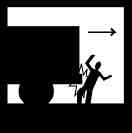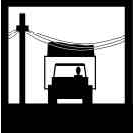Transporting
crops from the field to the storage or processing center is
an important part of the farm operation. Farm trucks compete
with other drivers on the road and are susceptible to accidents
due to infrequent operation, poor roads or driving conditions,
inexperienced drivers, and poor equipment maintenance. Proper
maintenance and training are important to prevent a potentially
serious accident.
|
|
|
|
Truck
Overturns -Major causes of accidents are driving
too close to ditches or on soft shoulders, driving on
slopes with an uneven load, and raising the truck bed
on uneven ground. Crushed by the Bed -Failure to block a raised bed while working on the hoist can result in the bed coming down on a person. Backing-About 25 percent of accidents involving trucks are a result of backing over a person or into an object. Vehicle Collisions-Accidents resulting from poor brakes, nonworking signals, or driver fatigue are common during the harvest season. Transporting Equipment or Other Materials on Trailers -Failure to load and secure equipment or other materials properly can cause the load to either fall off trailers or cause the towing vehicle to lose control. Overloaded Trucks or Trailers- Overloading trucks or trailers puts additional strain on the vehicle, particularly the brakes and tires. Towing a trailer with a weight heavier than the towing vehicle will lead to loss of control, especially down hills. Loads That Shift Weight -Livestock will shift weight when turning corners or when making sudden swerves. Liquids in tanks will slosh back and forth if no baffles are installed in the tank. Maintaining the control of a truck is difficult when weight slips especially on poor road conditions. |
 
|
|
|
|
|
Trucks 1. Proper maintenance is important for truck safety. Daily inspection should include checking tire pressure and condition, brake and all other fluids, lights and turn signals, as well as making sure that windshields are clean and mirrors are clean and adjusted properly. 2. Be familiar with the truck operation and driving characteristics before operating the truck (e.g., room needed to make a turn or how high the bed will be raised. New drivers need to have a valid driver's license and be trained before hauling loads. Drivers need to be aware that a loaded truck will take longer to stop than other vehicles. 3. Follow all traffic laws established for the state. 4. Drivers need to be alert when driving any vehicle especially a truck. A loaded truck takes longer to stop and get up to highway speed than other vehicles. Cars pulling out in front of trucks are common, making it necessary to slow down. Drivers need to take frequent safety breaks such as stretching and breathing deeply. Getting out and walking around the vehicle helps. If feeling drowsy, stop and have some coffee or soup-don't drive. 5. Increase the following distance from other vehicles on the road. Use the 4-second rule-count 1001, 1002, 1003, 1004. 6. Keep the same distance away from a ditch as the ditch is deep in fields on unstable roads. 7. Do not drive on soft shoulders of road-ways be-cause the shoulder can give way causing a loaded truck to tip over. 8. Be aware of the conditions of the field. Make sure that drivers are aware of any potential problem areas in a field. 9. On hilly terrain drive trucks on top of hills. Travel as much as possible straight up or down hills. Traversing a hill with a load will cause a problem especially if the load is concentrated on the down-hill side. Keep the load evenly distributed. On extremely hilly ground it is better to bring the combine to the truck than drive the truck to the combine. 10. Make sure that approaches and bridges are adequate to carry the weight of a loaded truck. 11. Regularly inspect brakes on semi trailers. 12. Be aware of the "blind spots" in mirrors, especially when turning and changing lanes. 13. Sound horn when backing to indicate your intentions. Be aware of others in the area. In a congested area either have a spotter direct you or get out of the cab and look over the situation before backing up. Consider installing backup alarms. 14. Be aware of children in the area. Before moving a truck know where the child is at all times. 15. Be aware of the characteristics of the load that is being carried. Livestock will have a tendency to shift during turns while in transport, liquids will slosh if the tank is not full, and high loads may come into contact with power lines or tree branches. 16. Load and unload equipment using a solid loading ramp. Trying to drive onto a trailer or truck from a roadbed is risky and has been a cause of many accidents. 17. Before loading a truck or trailer be sure to use wheel chocks to prevent the truck from moving while being loaded. 18. Do not overload a truck. An overloaded truck is hard to steer and stop. Also, the additional weight puts stress on the tires, suspension, cooling system, and drive train. 19. When parked set the parking brake and move the shift lever to the neutral position if the engine's running and put in gear when engine is stopped. 20. Always block or brace the bed of a truck when working on it in the raised position. 21. Make sure load clears overhead obstacles such as power lines, bridges, and overpasses. 22. Only raise a loaded bed on level ground. A raised bed rises the center of gravity. Side overturns are common on sloped ground or when a truck makes a turn with the bed raised. 23. Maintain conveyer belts and pulleys in beds equipped with them. Make sure electrical connections are in good condition and wired and grounded properly for the site that they will be used. |


|
| Trailers | |
|
1. Make sure trailers are properly hitched to the towing
vehicle. Use safety chains and attach the lighting connector.
Make sure signal lights work properly. 2. Inspect tires and wheel bearings before each use. Make sure bearings are properly lubricated. If the trailer has brakes inspect them daily and make sure all connections are in tact. 3. Load and unload on level surfaces. Always make sure the brakes are locked before loading. 4. Use tie downs or chain binders to secure loads to the trailer. Check bindings after you traveled some distance to be sure the load has not shifted. 5. Load trailers properly. Put about 60 percent of the load toward the front. Too little weight in the front will cause the trailer to fishtail. Too much weight will cause the hitch to drag and may raise the front of the towing vehicle, which reduces steering control. 6. Keep decks free of dirt, oil, and debris. Steel decks can be slippery when wet, and extra caution is needed when loading and unloading. 7. Do not overload the trailer. Make sure the truck will be able to handle the load. Check the owner's manual of the truck for gross vehicle weight and other information regarding towing capacities. 8. When towing a trailer down a hill use the same gear and speed as when going up the hill. 9. Make sure tilt beds are in the locked position before moving. |


|
Written
by Tom Karsky, University of Idaho, and A. K. Jaussi, former
graduate assistant, Washington State University. For more
information about farm safety, please contact:
| Published December 1998 | Hand Signals |
Disclaimer and Reproduction Information: Information in NASD does not represent NIOSH policy. Information included in NASD appears by permission of the author and/or copyright holder. More